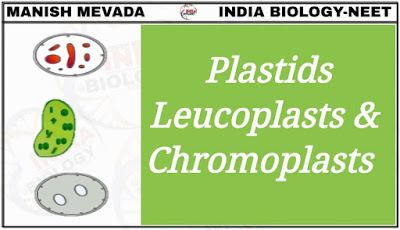STD-11 UNIT-3 CHA-8
CELL : STRUCTURE AND FUNCTIONS
Plastids
- The term plastid was introduced by E. Haeckel in 1866.
- Plastids are semi-autonomous organelles having DNA and double membrane envelope which store or synthesize various types of organic compounds.
- With the exception of some protistans, (e.g. Euglena, dinophyceae, diatoms) plastids are restricted to plants only, Plastids develop from colorless precursors called proplastids.
- Proplastids have the ability to divide and differentiate into various types of plastids.
- Depending upon their color, plastids are of three main types- leucoplasts, chromoplasts and chloroplasts (Schimper, 1883).
- They are colorless plastids which generally occur near the nucleus in nongreen cells and possess internal lamellae.
- Grana and photosynthetic pigments are absent.
- Leucoplasts have variable size and form,e.g. rounded, oval, cylindrical, filamentous, etc.
- There are three types of special leucoplasts.
- Amyloplasts. They are the starch containing leucoplasts.
- An amyloplast is several times larger than the original size of leucoplast.
- It contains a simple or compound starch.
- grain covered by a special protein sheath,eg, Potato tuber, Rice, Wheat.
- Elaioplasts (Lipidoplasts, Oleoplasts).
- The colorless plastids store fat, eg.Tube Rose.
- Aleuroplasts, Proteoplasts or Proteinoplasts.
- The plastids Contains protein in the amorphous, crystalloid or crystallo globoid state (eg, aleurone cells of Maize grain, endosperm cells of Castor).
- The plastids are yellow or reddish in color because of the presence of carotenoid pigments.
- Chlorophylls are absent.
- Chromoplasts are formed either from leucoplasts or chloroplasts.
- Lamellae degenerate per tially or completely during chromoplast formation.
- Change of color from green to reddish during the ripening of Tomato and Chilli is due to transformation of chloroplasts to chro moplasts.
- The orange color of carrot roots is due to chromoplasts.
- The pigments are often found in crystallised state so that the shape of the plastids can be like needles, spindles or irregular.
- Chromoplasts provide color to many flowers for attracting pollinating insects.
- They provide bright red or orange color to fruits for attracting animals for dispersal.
- They are also the site of synthesis of membrane lipids.
========================================






Please do not enter any spam link or word in the comment box